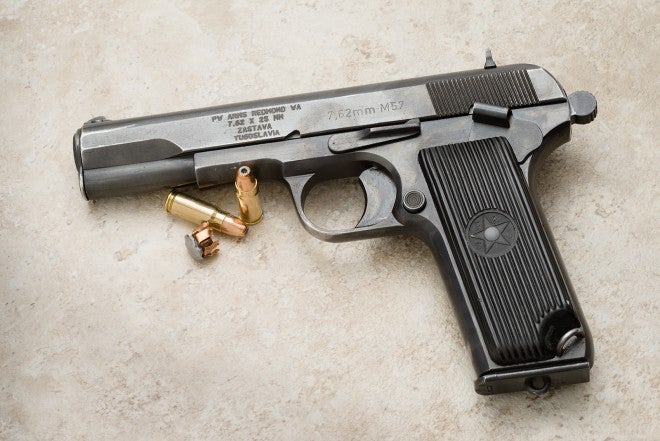Is 7.62×25 Appropriate for Self-Defense?
Oleg Volk 04.06.15

7.62×25 Tokarev cartridge is a higher-pressure 1930 update of the 1896 high-velocity 7.63mm Mauser. Originally designed for pistols, it was also used in several submachine guns. As a result, it used mainly medium speed powders and produces a substantial muzzle flash. Most of the ammunition available is military surplus, with thick jackets and great penetration–a predictable product of high velocity and small cross-section. A typical Tokarev-chambered pistol launches 85 grain bullets at around 1400fps at the muzzle. Some surplus and modern factory loads approach 1500fps. In gelatin, that gives a straight line 30-caliber 30+ inch long wound channel that widens only where the bullet flips end over end once. The plus side of the load is its high penetration, sufficient to defeat car body panels and lower-level body armor. The down side is its high penetration, almost guaranteeing that the bullet will exit an unarmored opponent and keep on going. For a defensive round in an urban environment, that’s a liability.
Despite this potential problem, quite a few people carry pistols in 7.62×25. They are relatively inexpensive, robust, and have a dieselpunk style to them. The two most popular models are CZ vz.52, a roller-lock delayed blowback Czech pistol, and a TT33, a Soviet locked beech design with very simple lockwork.


TT33’s simplified lockwork means that it cannot be carried cocked and locked despite being a single action design. By doctrine, it should be carried at half-cock, but safety of that practice is in question.
The accuracy of TT33 and vz52 varies from good to poor, depending on the barrel condition and the trigger. Soviet-made TT33 has a narrow, sharp trigger face, which makes the heavy pull even more problematic. The sights of a Czech pistol are typical tiny metal nubs. TT33 uses a tall, narrow front blade and a wide rear notch, a design that works fairly well even in poor light. Both designs are reliable, and the bottlenecked casing shape helps with easy extraction.

Most recently, a Yugoslav M57 variant of TT33 has become available in the US. Broadly similar to the original, it has a longer grip and holds an extra round in the magazine, bringing the total capacity to 9+1. It also has a 1911-style safety that blocks the sear.
Wider trigger face helps with the still heavy trigger pull. With a pistol that can be carried safely, the interest in the cartridge has increased again. Unfortunately, surplus ammunition has largely dried up, and most of the commercial loads are plain ball with the usual over-penetration problem.


This ammunition proved extremely consistent, with measured velocity always in the 1403-1408fps, even in different weather. It’s behavior in gelatin has been quite consistent as well, with 16″ of straight line penetration and reliable expansion to .45 caliber. For comparison, 45ACP Winchester Ranger SXT also penetrates 16″, though expanding to .90 caliber in the meantime. So we can estimate wound channel of 7.62×25 to be similar to that of 45ACP ball, but with penetration limited to that of hollow point bullets. The smaller, faster bullet produces greater temporary stretch cavity due to the higher impact velocity.


Advantages of 7.62 JHP over 45ACP are capacity for the same magazine size, flatter trajectory, slightly lower felt recoil. The same advantages were cited in support of 38 Super ammunition back in the 1930s. Not surprisingly, one of the export variant of TT33 included a 38 Super barrel as well as a 9mm Luger barrel. Shorter 9mm cartridges required a magazine spacer for reliable feeding, but 38 Super fit just fine. For short-range use with pistols, 45ACP JHP is quite obviously superior to 7.62 JHP in terminal effect. The question is: “With improved ammunition, is 7.62×25 good enough to be considered a practical defensive round?” The answer, based both on gelatin testing and on hog hunting results, seems to be “Oh, very yes!”
